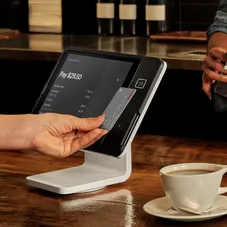Table of contents
Beyond being a tool for creating communities and driving users to your online store, social media is a sales channel in its own right.
Imagine, you’re idly browsing your feed and see a pair of jeans that are exactly what you’ve been looking for (but can’t find anywhere!), so you click the post’s “shop now” tag, punch in your preferred size and head to checkout. In no time at all, you’ve bought your new denim and are back looking at bouncing gorillas.
That’s the power of social commerce. The entire journey, from product discovery to research, social proof and checkout, all take place in app.
And it’s growing at an incredible rate, with worldwide revenue expected to double from an already healthy US$751 billion in 2022 to US$1.59 trillion by 2025.
In Australia, of the 1,000 consumers we spoke to for our 22/23 Future of Retail report, 53% – that’s about 10.4 million adults – have used social media to shop online. We also spoke to 500 retailers, with just over half (54%) of them saying that social media channels account for most of their revenue. Of the various platforms offering social commerce, 40% of these retailers said Facebook was their lead sales channel, 25% nominated Instagram and for 14% TikTok was most important.
As you might expect, younger people are particularly primed for social shopping. Afterpay spoke to over 4,000 young consumers across Australia, New Zealand, the US, UK and Canada. According to their findings “Gen Z doesn’t just love social media – it’s become part of their lives. It’s a means of communication and constant networking, a way to socialise and purposefully build identity, a way to follow and influence trends, learn new skills and, maybe most importantly, it’s a source of inspiration, especially for shopping.”
With Square’s Meta Integration, so you can connect directly to your Facebook and Instagram pages, sync your products and increase your online channel sales. You can build out your store in app, allowing customers to browse your products and collections. Plus, your inventory will update automatically on your Square eCommerce site.
Almost all the other major social platforms also offer a form of shopping tool.
TikTok is fully searchable and, since nearly 60% of Gen Zs browse social media for shopping inspiration, with the right key words you have a good chance of turning up when they’re searching for a product. If you have a TikTok business account, you can add shopping tags to your products in videos and direct shoppers to your shopping page to complete a purchase.
Many businesses create YouTube content that resonates with their target audiences, such as advice, how-tos, product demonstrations, or user stories. The platform now gives creators the ability to promote products in video.
Tip: Make sure when a user lands on your video they have a way to navigate to your online store.
Pinterest, Snapchat, Twitter (it’s not just for news!), Twitch and WeChat also have their own social commerce features.
Putting it into practice
So, what’s the best practice when it comes to social commerce?
Put the social back into social media
Social media should be, well, social. Influencer Marketing Hub describes it as “engaging vs analytical, emotional vs transactional, and focused on friends and creators vs celebrities and big brands.”
Shoppers look to social media as a trusted source for inspiration, product recommendations and reviews, just as they would read on Google or Amazon. According to research by Sprout Social product awareness can begin by seeing a targeted ad (49% of consumers), an organic post by a brand (40%), their own in-app research (34%), seeing a friend’s post (34%) or hearing about it directly by being tagged or via DM (22%).
The goal is to get your customers to spread the word about how great you, your services and your products truly are.
Tip: You can send automated post-purchase emails asking for reviews.
Or you could run a competition like Aussie brand Eureka Furniture. Their website features an inspiration page and customers are encouraged to tag the brand in an Instagram post to go in a draw to win $500 worth of furniture.
If your customers tag you in their own videos – for example, wearing your clothing or jewellery – that’s brilliant. Whatever kind of user-generated content (UGC) you can create, there are plenty of creative ways to share it – with a “shop now” product tag of course! You could share on Instagram Stories, repost in your feed, or collect positive reviews into a carousel post.
Just be sure to ask for permission before reposting any user-generated content. The last thing you want is to turn a happy customer into a negative review. Better still, reaching out may even turn an already positive buyer into a brand advocate.
Lights! Camera! Product in action!
From showing off how your jeans or jewels – social media is great for sharing content that show your product in action.
Tip: Share the origin story of a product, offer tutorials (makeup lessons are massively popular for a reason), or delve into the pain points you’re solving for your customers.
Location, location, location
This one’s simple but effective. Let your customers know where they can find you, whether that’s online or in person. Add your business location so people can tag you on their stories and posts. Instagram, for example, allows users to pick from existing locations when they’re sharing. If you’re not on the list you’ll miss out on being tagged.
Get engaged
When customers or prospective sales engage with your content, make sure you engage back. There are many forms of engagement, but let’s concentrate on comments, indirect mentions (about you, not to you), branded hashtags, and direct @ (your brand here) callouts. These are all opportunities to build on a connection someone has with your business.
Social media tool Hootsuite has a useful article on engagement and they say, “Some may think of conversation as an art, but in some ways, it’s really more of a sport: volleying attention and questions back and forth.”
In this sport, it’s important to helpfully and speedily answer any customer questions, respond to comments with warmth or humour, and acknowledge any reviews – especially a negative one. If you get a like, repost or retweet, go beyond that and reply with a comment to start a conversation. Showing the people behind the brand in photos or videos, or encouraging team members to sign replies with their names, can go a long way to forming a personal connection.
While it might not be strictly in-app social selling, posting about your Square rewards program can be another good way to cement the link between engagement and long-term customer loyalty.
Lock on to your target
With its wealth of customer data, social media takes the guesswork out of finding your perfect customer. For example, targeted advertising makes it easy to promote your sustainable, cruelty-free skincare products directly to eco-friendly conscious shoppers.
Read: You’ll find plenty more tips in our guide to digital marketing.
Join the discovery channel
Lastly, mark your calendar with opportunities for organic discovery and jump on the relevant hashtags so consumers can find you. Valentine’s Day in February, Afterpay Day in May, #EOFY in June and Black Friday/Cyber Monday in November are just some of the big dates. It might help to think about specific events relevant to your brand, like Australian Fashion Week or the Spring Racing Carnival.
![]()











